
09 Sep Assortment in product data management
Are you also spending too much time and resources preparing assortments for your customers, wholesalers, marketplaces, eProcurement portals in various formats (e.g., ETIM BMEcat, FAB-DIS, ETIM xChange, JSON, XML, EXCEL, CSV, etc.)? Or perhaps you wish that your sales team could actually create such assortments quickly, easily, and without requiring in-depth data knowledge? In fact, assortment management in product data management can really be quite simple too. As a feed management and data syndication solution, CatalogExpress offers you a variety of options to efficiently, individually create electronic catalogs with customer-specific assortments in high quality.
Learn more about how an assortment in product data management can work with CatalogExpress in our latest article.
Which assortment options are available?
CatalogExpress provides three options to define and create assortments for your data receivers:
- Assortment determination from ERP, PIM, inventory management system, or other sources,
- Assortment determination via mapping,
- Assortment determination via a template file.
Assortment determination from ERP, PIM, inventory management system, or other sources
This approach might be particularly suitable for you if you’ve already stored assortments internally. For example, you can import these from your PIM (Akeneo, ATAMYA (eggheads), Contentserv, Crossbase, OMN by Apollon, Oxid, Pimcore, Viamedici etc.), ERP, inventory management system, or an EXCEL file into CatalogExpress. This is the simplest case in assortment management. For this purpose, the feed management and data syndication software already offers numerous connectors or standard interfaces (including Akeneo, Contentserv, crossbase, eggheads / ATAMYA, OMN, Pimcore, Viamedici, and many more).
For the assortment management, you can simply go ahead and select your source in the mapping interface of CatalogExpress. In this particular example, it happens to be a PIM system.

Assortment is done from the PIM system.
Next up, you’ll want to map the source attributes, like product description, GTIN, etc., to the corresponding target attributes. In this particular case, the source attributes were actually mapped to a ETIM BMEcat 2005 format.
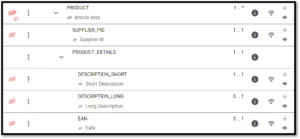
Excerpt from the data mapping of a BMEcat 2005.
After having mapped your data once, you can then subsequently provide the catalog to your data recipients (e.g., wholesalers, marketplaces) either automatically or manually.
In addition to just using a single source, you can also get assortments from multiple different sources (EXCEL, CSV, PIM, ERP, etc.). For example, you can use customer-specific assortments stored in the ERP and combine them with product information from the PIM system. To do this, you need to select and connect these sources in CatalogExpress. Additionally, you must define a unique identifier that is present in both sources. This essentially allows CatalogExpress to clearly understand the relationship between the different systems. This could be, for instance, the article number. Next, map all source attributes to the respectively fitting target attributes. Afterward, you can easily provide the catalog to your wholesalers, eProcurement platforms, marketplaces, etc., either automatically or manually.
Assortment determination via mapping
In addition to assortment management through specific sources, you can also select your product data using the mapping functions. This way, you can create your catalogs based on certain attributes (e.g., customer number, product categories, ECLASS or ETIM codes, etc.).
Let’s say you want to create a product data catalog exclusively with the product category “Garden Tools.” In order to do this, go to the output page in the mapping for product iteration. Click on the “three dots” on the left and select “Add Filter.” Here, you can decide whether to exclude or include data. In our example, we want the filter to include product data belonging to the “Garden Tools” category.
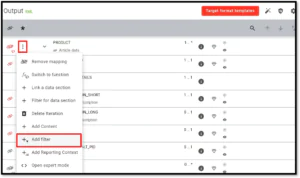
Assortment via filter function.
Now, additional elements will appear in the mapping.
To create a selection, simply use the “equals” function as the condition. For assortment based on the criterion “Garden Tools,” the data mapping would look like this:
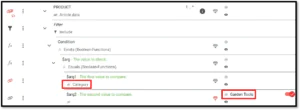
Application of the filter for assortment determination of garden tools.
Once all source attributes are successfully mapped to the target attributes, you can go ahead and initiate the catalog creation process. You will then receive an electronic catalog that only contains the product group “Garden Tools.” You can now provide this catalog to your data recipients either manually or automatically via CatalogExpress.
In fact, this particular use case can easily be extended even further. For example, you can narrow down assortments not only by categories, but also by customer numbers and functionalities simultaneously. This allows you to create an assortment that includes items asigned to a specific customers, and that are belong to the category “Garden Tools,”, and that contain the product feature “battery-operated.”
With these mapping functions, you can also define complex assortments with various dependencies.
Assortment determination via a template file
Thanks to the various user roles in CatalogExpress, a different department or position can also take over assortment management as a part of your product data management. In other words: No specialized knowledge of interfaces, product data, or exchange formats is required. For example, the sales department can also be integrated into the process. Only a few preparations need to be made by the manager role in CatalogExpress. For this, your data manager provides a “catalog template file” for the respective employee. This file can be structured in various ways. Traditionally, assortments are determined only by article number. However, if you want your sales team to also influence the price, this can be accommodated as well. In our example, the catalog template is an EXCEL file with columns for article numbers and prices. It could as well be a CSV, XML, or JSON file though.
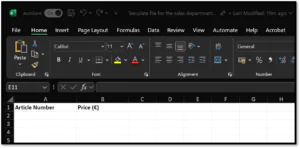
Example representation of a template file for sales.
Next, this template file is uploaded in the mapping of CatalogExpress. To do this, your data manager imports the template file as a source in the CatalogExpress mapping. In the source configuration, they define the “Type: Upload” and “Trigger: Process Start” under the input configuration.
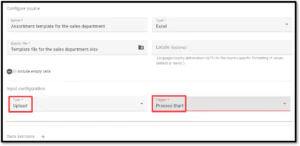
Configure template file in CatalogExpress.
This allows your sales team to upload a file in the structure of the template file with customer-specific prices, products, etc., during the catalog creation process. This file could, for example, have been exported from the ERP system.
In order to do this, your sales team logs in to CatalogExpress with the Creator role. Then, during catalog creation, they select the appropriate profile. Under “Catalog Template for Sales,” they can then upload their assortment with customer-specific prices. Now, they just click “Start,” and that’s it.
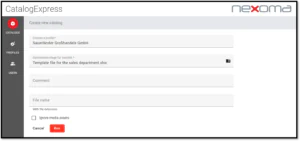
Create an electronic catalog with an assortment template.
Within just a short time, the electronic catalog that contains customer-specific prices will be available for download. This also allows your sales team to define assortments easily and provide them to wholesalers, customers, and other data recipients. The catalog format can vary as well. Your sales team can therefore assort and generate any assigned catalog profile in CatalogExpress, whether it’s ETIM BMEcat, ETIM xChange, FAB-DIS, DPB, EXCEL, CSV, XML, JSON, and many more.
Of course, it is always a matter of process and data governance policies whether you choose to integrate the sales department into this process. A direct integration with ERP systems may not always be permitted. Therefore, exporting data from the ERP for the assortment determination can be a possible compromise for data governance though.
Use a combination of all assortment opportunities
Of course, you could also combine all types of assortment management in CatalogExpress. For instance, your data manager can set up a filter in the mapping to ensure that only active items from the PIM system are included in the catalog. They may also configure a product data validation. When your sales team (in the Creator role) starts a process and uploads an assortment that includes inactive products, these products will not be included in the output. The product data validation ensures that your sales team or data manager will see why not all products were included in the reporting. This additional security check helps you identify and prevent outdated product data or inactive items.
How do you get access to these the assortment management features?
You can use these assortment management capabilities in the standard NEWCOMER version of CatalogExpress. If you have any questions about assortment management or the feed management and data syndication solution CatalogExpress, feel free to schedule a free consultation with us.
Schedule a consultation